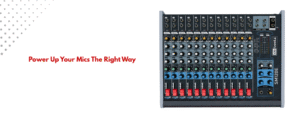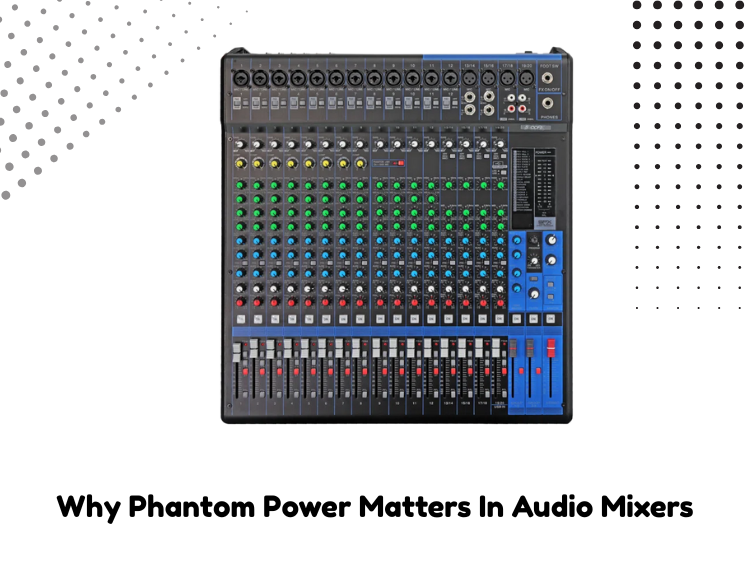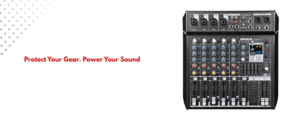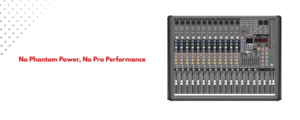You may have heard of “phantom power” on your audio mixer if you work with live sound or set up a studio. It might sound strange, but it is very important for your mics and other recording gear to work right. If you know what phantom power is, how it works, and why it’s important, you can get better sound quality and avoid technical problems. Why is phantom power important in audio mixers? This post will explain it and show you how to use it correctly.

How Do You Use Phantom Power?
DC (direct current) electricity can be sent through microphone cords to power some mics and recording devices. This is called “phantom power.” It usually sends 48 volts of power through the same line that carries radio data. That’s why it’s called “phantom”—you don’t see any extra wires or batteries, but the power is there. This function is mostly used for condenser mics, whose internal electronics and diaphragm need to be powered from an outside source. These mics will not work without phantom power. For example, when using a condenser microphone in a studio setup, phantom power is necessary to make the mic functional.
For What Reason Do Condenser Microphones Need Phantom Power?
Dynamic microphones use a magnetic coil and don’t need external power. Condenser microphones, on the other hand, use an electrically charged diaphragm to pick up sound more clearly and sensitively. This design lets you:
- More detailed highs and lows
- Better reaction to transients
- More sensitive all around
The electronics inside condenser mics, on the other hand, can’t work without power. Phantom power from the mixer gives you this energy quickly and safely, so you don’t have to carry around heavy batteries or separate power sources.
The Right Way to Use Phantom Power on a Mixer
Phantom power is a feature that most current audio mixers have. How to use it:
- An XLR wire is needed to connect your microphone because 1/4-inch jacks don’t work with phantom power.
- Make sure that the microphone you want to use needs phantom power. Only turn it on if you are using condenser mics or active DI boxes that need it.
- Turn on phantom power, which is generally marked as +48v on a mixer. Some mixers give all XLR inputs phantom power, while others let you control it only for one channel.
- Before adding or removing mics, you should always turn off phantom power to avoid pops or damage.
Why Phantom Power Is Important for Your Workflow
When mixing music, phantom power is very important because:
1. Enables the Use of High-Quality Microphones
These mics can’t work without phantom power. If you want singing or instrument recordings that sound like they were recorded in a studio, you’ll need condenser mics and, by extension, phantom power.
2. It Works with Active DI Boxes
Phantom power is also needed for some Direct Injection (DI) boxes that connect instruments to mixers, like electric guitars and computers. It helps keep the tone and sends a clean sound to your mixer.
3. Gives You More Options for Equipment
You can use more than just dynamic mics with phantom power. There are many types of condenser mics that can be used for different types of recording, such as:
- Tracked singing
- Instruments for sound
- Overhead drum mics
- Choir and background room recordings
This gives sound engineers and artists the freedom to make the tone and mix of sound they want. If you’re looking to learn more about connecting your mixer to other equipment or improving your live sound, you may find the article on Mixing Tips for Live Streaming: How to Get the Best Sound useful.
How to Stay Safe When Using Phantom Power
- Most classic ribbon mics can be hurt by phantom voltage, so never use it on ribbon microphones unless they were made to handle it.
- For phantom power that doesn’t cause noise or crosstalk, use balanced XLR cords.
- If you’re not sure if phantom power is applied per channel or generally, you should always check the mixing instructions.
For additional tips on maintaining your gear and ensuring longevity, you can explore our Step-by-Step Guide to Cleaning and Maintaining Your Audio Mixer.
Conclusion
Phantom power might not seem important when mixing audio, but it is a key part of getting good recordings and live sound. Understanding and using phantom power correctly will ensure that your condenser mics and DI boxes work at their best, whether you’re a beginner setting up a home studio or a professional working at live shows. When you use phantom power and when you don’t, can make a big difference in how clear your sound is and how long your gear lasts. It’s not just a mixing setting; it’s important for getting good sound.
Want to build your setup or start selling audio gear? Explore 5 Core’s Business Partnership Program for exclusive discounts, same-day U.S. shipping, and no subscription or minimum purchase requirements—ideal for growing a sound-focused business.



